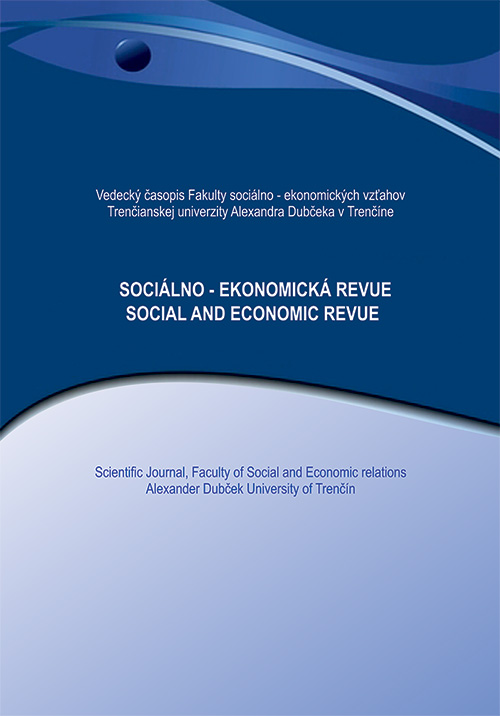ANALYSIS OF THE EXPECTED DEVELOPMENT OF DEMOGRAPHIC FACTORS AND THEIR ADAPTATION TO THE LABOR MARKET IN SLOVAKIA
The research subject of our work is demographic development as a factor of labor market development in the Slovak Republic. The aim of this paper is to point out the topicality of the researched issue, which is the demographic development of the population in terms of age, birth rate and mortality and their impact on the labor market in Slovakia. In the first part, we will approach these factors fundamentally influencing the labor market from a theoretical point of view with the help of an analysis of the literature on the given issue. In the next part of the paper we will focus on statistical indicators of demographic development. Also in this section we will focus on indicators of the age of the population of the Slovak Republic and the economically active population by age groups. We will point out the measures taken by the government to eliminate the risks posed by possible developments. Every advanced society strives to create the conditions now for sustainable social and economic development in the future. Economic and social development is closely linked to the labor market. Migration can alleviate the process of population decline in Slovakia, but it will have only a minimal impact on the process of population aging. The contribution can be the use of the post-productive population, migration as the primary source of absent labor and preparation for labor shortages.
Vydanie: 2020/1 Strany: 40-50 Klasifikácia JEL: J1, J6, F01, J11
DOI:
Kľúčové slová: demographic development, labor market, economically active population, age group, productive age, birth rate, mortality
Sekcia:
Kontakty:
Ing. Andrea Horváthová
Faculty of Social and Economic Relations
Alexander Dubček University of Trenčín
Študentská 2
911 50 Trenčín
Slovak Republic
horvathova.ada@gmail.com
Ing. Jaroslav Éhn
Faculty of Social and Economic Relations
Alexander Dubček University of Trenčín
Študentská 2
911 50 Trenčín
Slovak Republic
jaroslavehn@azet.sk
Literatúra:
Bleha, B., Vaňo, B. (2003). Niektoré teoretické a metodologické aspekty populačnej politiky a náčrt jej koncepcie pre Slovenskú republiku. Dostupné na: www.infostat.sk/vdc/pdf/cl49.pdf
Choi, K. –Shin, S. (2015). Population aging, economic growth, and the social transmission of human capital: An analysis with an overlapping generations model.In Economic Modelling Vol. 50, 2015, p. 138–147.Amsterdam: ELSEVIER 2015.(WOS).
Dennison, T., & Ogilvie, S. C. (2016). Institutions, demography, and economic growth. Journal of Economic History,76, 205–217.
Divinsky, B. (2004) Migration Trends in Selected EU Applicant Countries, Vo-lume V-Slovakia-An Acceleration of Challenges for Society, 1st edition, Vienna,International Organization for Migration, 136 pp., ISBN 92-9068-185-3
Green paper of the EU, Confronting demographic change: A new solidarity between the generations. Brussel, EUROPEAN COMMISSION, 2005.
Krajňáková E., (2019). Migrácia občanov Slovenska za prácou do zahraničia v kontexte európskych migračných tokov pracovnej sily. Sociálno – ekonomická revue / 04 – 2019
Inštitút zamestnanosti. (2013). Demografický vývoj. Dostupné na: https://www.iz.sk/sk/projekty/inkluzivny-rast/demograficky-vyvoj
Lisenkova, K., Mérette, M. and Wright, R. (2013). Population Ageing and the Labour Market: Modelling Age-specific Effects for Scotland”,Economic modelling, Vol. 35, p. 981-989. Amsterdam. ELSEVIER 2013.(WOS).
Lubyová, M. –Štefánik, M. et al. (2015). Trh práce na Slovensku 2016 +.Bratislava: Ekonomický ústav Slovenskej akadémie vied. s. 18 –19. ISBN 978 –80 –7144 –255 –4
Lucassen, L. (2016). Working together: New directions in global labour history. Journal of Global History,11, 66–87. doi:10.1017/S1740022815000352
Massey, D. S. a kol. (1993). Theories of International Migration. A Review and Appraisal. In: Population and Development Review. Volume 19, číslo 3. September 1993, s. 431-466, tu s. 432.
MPSVR. (2019). Ministerstvo pripravuje stratégiu Práca 4.0. Dostupné na: https://www.employment.gov.sk/sk/informacie-media/aktuality/ministerstvo-pripravuje-strategiu-praca-4-0.html
MPSVR. (2019). Situácia na trhu práce v roku 2019. Dostupné na: https://www.employment.gov.sk/sk/informacie-media/video/situacia-trhu-prace-roku-2019.html
Národný program aktívneho starnutia na roky 2014-2020. Dostupné na: https://www.employment.gov.sk/files/legislativa/dokumenty-zoznamy-pod/npas.pdf
Páleník, V. a kol. (2014). Strieborná ekonomika – potenciál na Slovensku. Bratislava : Ekonomický ústav Slovenskej akadémie vied, ISBN 978-80-7144-234-9. s. 81-82.
Pison, G. (2009). The population of the world Population&Societies, 2009,No.458, 8 pp., ISSN 0184 77 83 – dostupné na www: http://www.ined.fr
Punch, A., Pearce, D. (editors) (2000). Europe ́s Population and LabourMarketbeyond. Volume 2: Country casestudies. Populationstudies No. 34, Strasbourg : Council of EuropePublishing. s. 202
Radvanský, M. (2010). Makroekonomická prognóza vývoja slovenskej ekonómie zameranej na vývoj dopytu po práci.[online]. [cit. 2017 –10 –11]. Dostupné na: <http://www.expak.at/expakimgluploads/expak1231.pdf>.
Shrestha, L. B. (2000). Population aging in developing countries.p. 206 Washington: Project HOPE–The People-to-PeopleHealth Foundation, Inc.[online]. [cit. 2017 –09 –20]. Available on: <http://content.healthaffairs.org>.(WOS).
Strunz, H., Vojtovič, S. (2014). Vocational training and employment in the creative industry. In: SGEM conference on political sciences law, finance economics & tourism : Conference 306 proceedings volume III Economics & Tourism. - Sofia : STEF92, 2014. - ISBN 978-619-7105-27-8. - Technology, s.787-794.
Šprocha, Vaňo, Bleha. (2013). Prognóza populačného vývoja SR do roku 2060.[online]. [cit. 2017 –10 –11]. Dostupné na: http://www.infostaat.sk/vdc/pdf/Prognoza2060.pdf>.10.
VINCÚR, P. et al. (2001). Hospodárska politika.Bratislava: Sprint, s. 396. ISBN 80 –88848 –67 –9.
Štatistický úrad Slovenskej republiky. (2019). Ekonomicky aktívne obyvateľstvo podľa vekových skupín – ročné údaje. Dostupné na: http://datacube.statistics.sk/TM1WebSK/TM1WebLogin.aspx
Štatistický úrad Slovenskej republiky. (2019). Verejná databáza údajov. Dostupné na: http://statdat.statistics.sk/cognosext/cgi-bin/cognos.cgi?b
Štefánik, M. et al., (2018). Labour market in Slovakia 2019+ ŠEVT, a.s., Bratislava, ISBN 978-80-7144-296-7 e-ISBN 978-80-7144-297-4 , Pages: 168, pp. 12-57
Vaňo et al.(2002) - Prognóza vývoja obyvateľstva SR do roku 2050. Dostupné na: www.infostat.sk/vdc/pdf/prognoza2050vdc2.pdf
Vojtovič, S. – Krajňáková, E. (2017). Struggles of older workers at the labour market. In Economics & Sociology, Vol. 10, No. 1, p. 319 –333. ISSN2071 –789 x.(WOS).


